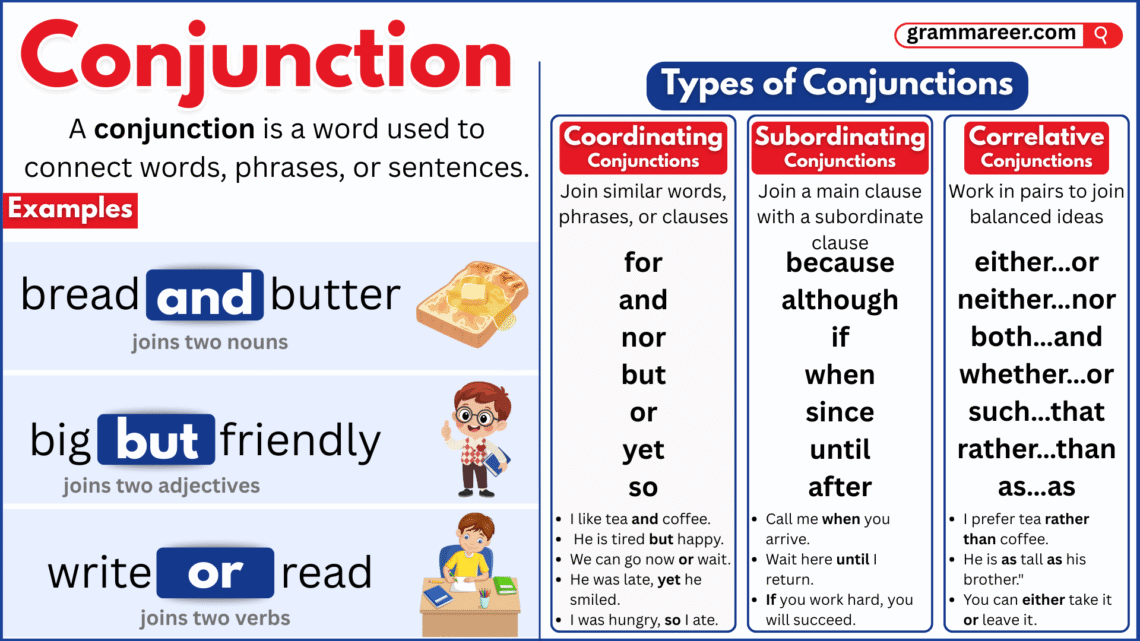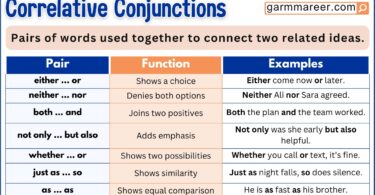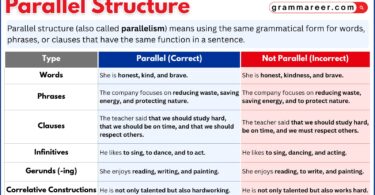What if we had to speak without using words that join our ideas? Our sentences would sound short, stiff, and disconnected. That’s why conjunctions are so important. They are the small words that link thoughts together, making our speech and writing flow smoothly. Words like and, but, or, and because are conjunctions we use every single day, often without even noticing.
In this article, we’ll explore what conjunctions are, the main types, and how they help us express ideas more clearly.
Table of Contents
What Are Conjunctions?
Conjunctions are the words we use to connect ideas in a sentence. They link words, phrases, and clauses so our language sounds smooth and natural. If we didn’t have conjunctions, our sentences would sound broken and incomplete.
Examples:
- I like apples and oranges.
- (and connects two words.)
- She is smart but sometimes careless.
- (but connects two phrases.)
- I stayed home because it was raining.
- (because connects two complete ideas and shows the reason.
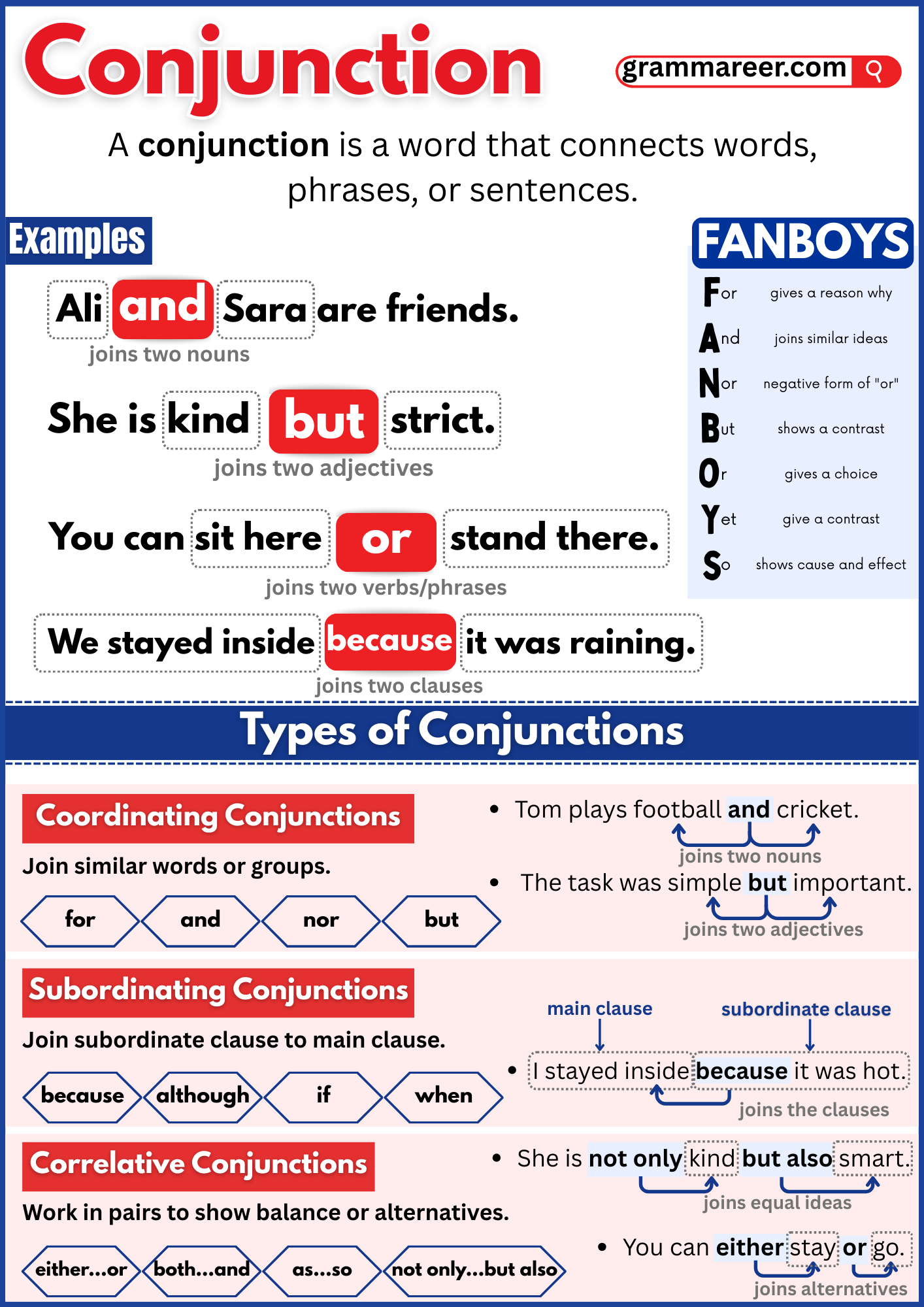
How to Use Conjunctions in Sentences?
Conjunctions are small words that join ideas together. They help your sentences flow instead of sounding broken. We mostly use words like and, but, because, if (these are common conjunctions) to join our ideas so they make sense together.
Conjunction joining words
The word “and” joins two single words (Ali and Sara). Conjunctions often link nouns, verbs, or adjectives when they are the same type.
Example:
- Ali and Sara are best friends.
Conjunction joining phrases
The word “but” joins two short phrases (tired and full of energy). Conjunctions can connect descriptions or ideas that add detail to the same subject.
Example:
- She is tired but full of energy.
Conjunction joining clauses
The word “or” joins two complete thoughts (You can watch a movie and You can read a book). Each part could stand alone as a sentence, but the conjunction ties them together smoothly.
Example:
- You can watch a movie, or you can read a book.
Types of Conjunctions
Conjunctions are of three main types. Each type has its own job in joining ideas.
- Coordinating Conjunctions
- Subordinating Conjunctions
- Correlative Conjunctions
Coordinating Conjunctions
These are the most common. They connect words, phrases, or even full sentences that are of the same level or importance. A simple way to remember them is with FANBOYS: for, and, nor, but, or, yet, so.
Examples:
| Conjunction | Example Sentence |
| For | We stayed inside, for it was raining heavily. |
| And | Tom plays football and cricket. |
| Nor | She doesn’t like tea, nor does she enjoy coffee. |
| But | The task was simple, but important. |
| Or | Do you prefer pizza or pasta? |
| Yet | He was tired, yet he kept working. |
| So | It was late, so we went home. |
Always keep in mind that when two complete sentences are joined with a coordinating conjunction, always put a comma before it. Like:
- She loves drawing, and her brother enjoys painting.
And make sure the two parts you join are in the same form (parallel).
Example:
❌ I like swimming and to dance.
✔️ I like swimming and dancing.

Correlative Conjunctions
These always come in pairs. Think of them as partners that work together. Common ones are: either…or, neither…nor, both…and, not only…but also.
Examples:
| Conjunction Pair | Example Sentence |
| Either / or | We will either watch a movie or play cricket. |
| Neither / nor | Neither the dog nor the cat is allowed inside. |
| Not only / but also | He not only sings well but also writes songs. |
| Both / and | Both honesty and hard work bring success. |
| Whether / or | She was unsure whether to laugh or cry. |
| As / so | As the sun sets, so the evening begins. |
| Rather / than | I’d rather walk than take the bus. |
The important thing here is balance—if you start with one, you must use its partner correctly.
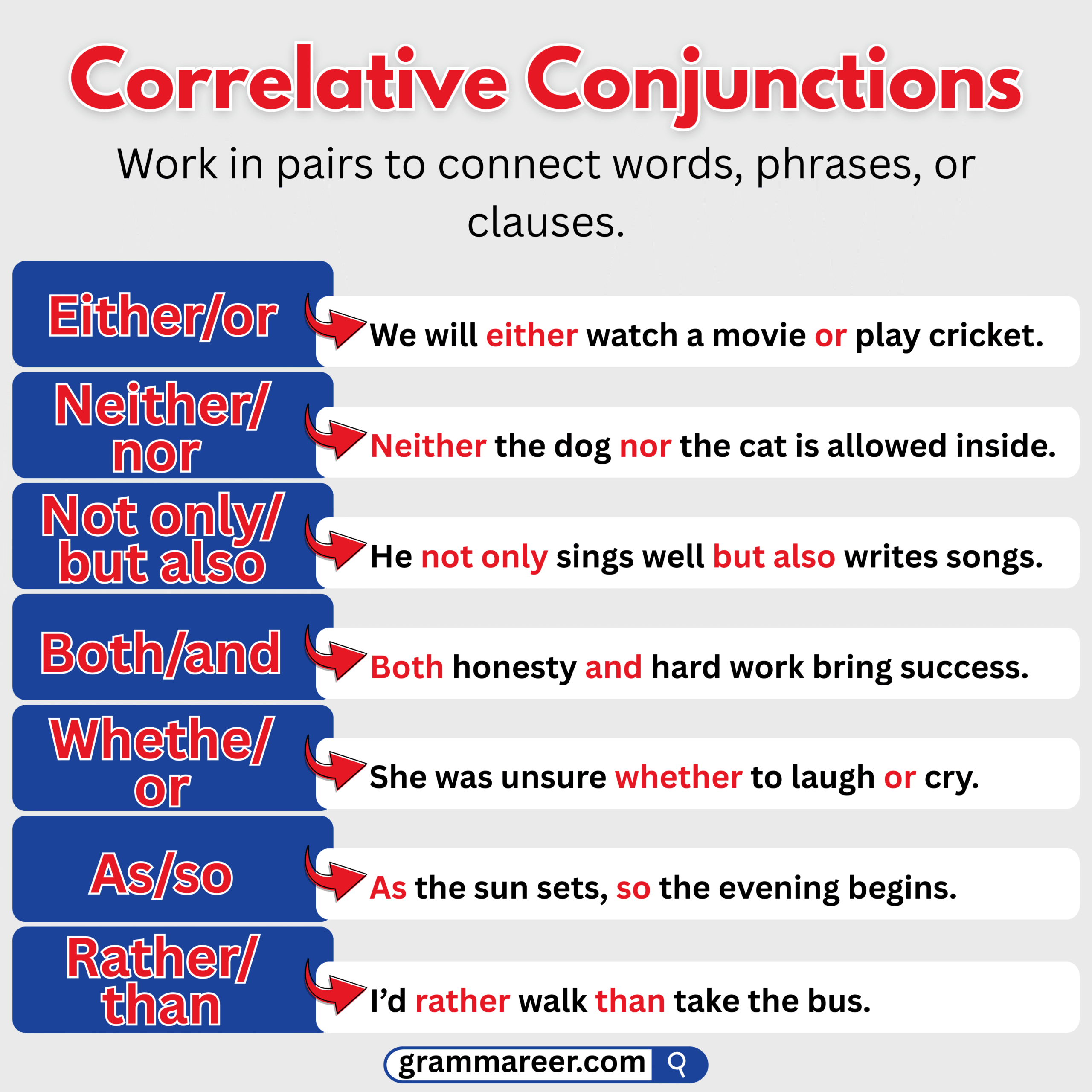
Subordinating Conjunctions
These are used when one part of the sentence depends on the other. They connect a main idea with a supporting idea. Common ones are: because, although, since, if, until, when, while.
- I stayed home because it was raining.
- She smiled although she was tired.
- We will wait here until the bus comes.
- If you study hard, you will pass the exam.
The part with the subordinating conjunction (the dependent clause) cannot stand alone.
❌ Because it was raining.
✔️ I stayed home because it was raining.
If the dependent clause comes first, use a comma:
- Because it was raining, I stayed home.
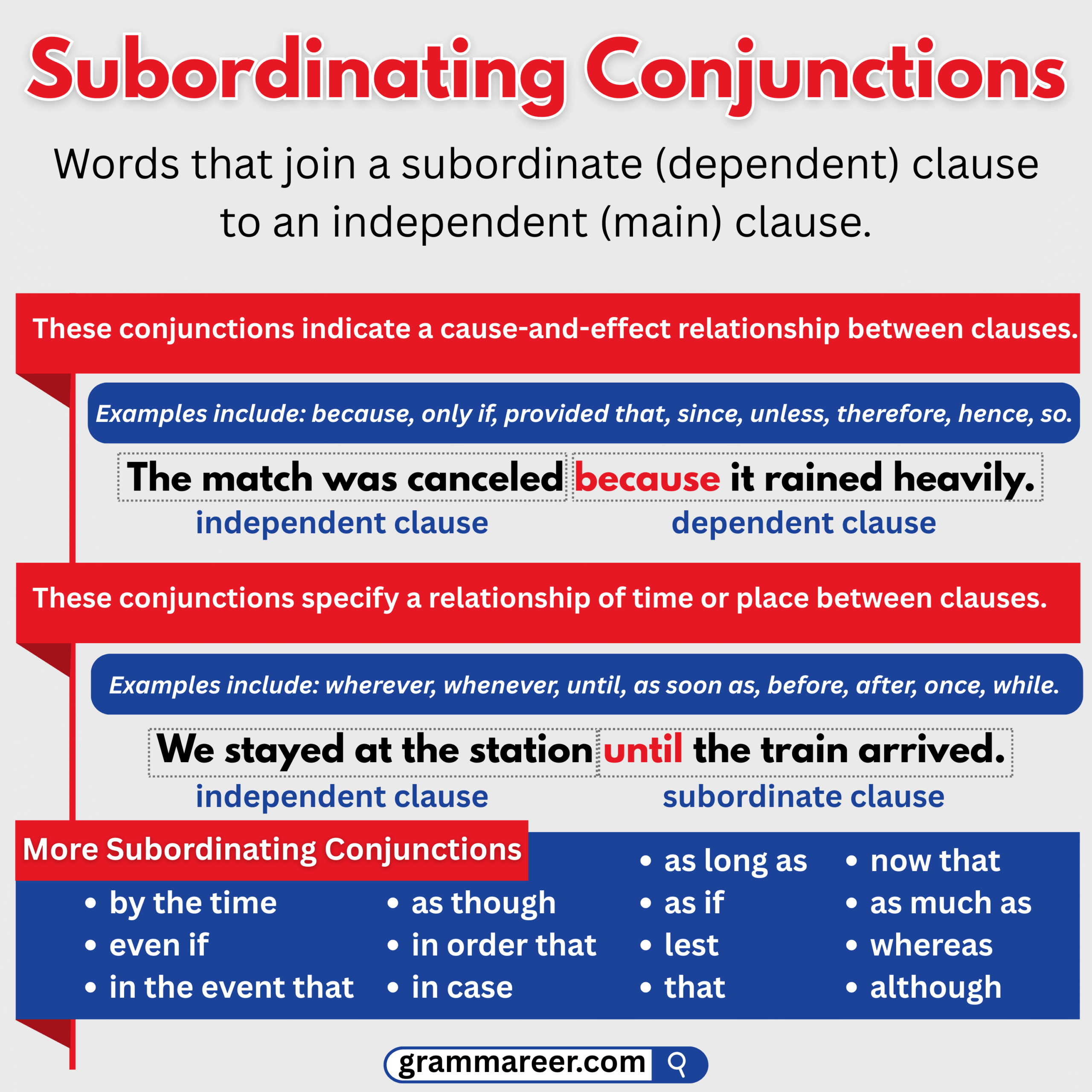
Conjunctive Adverbs
A conjunctive adverb is a adverb that works like a connector between ideas. Instead of just describing an action, it joins two thoughts and shows the relationship between them.
You can use a conjunctive adverb to connect two full sentences (independent clauses). When you do this, you usually place a semicolon (;) before it and a comma (,) after it. But they can also connect ideas between sentences or inside one sentence.
Conjunctive adverbs are helpful because they don’t just link ideas—they also show the meaning between them.
For example, they can show:
- Addition: also, besides, furthermore
- Cause and effect: therefore, consequently, accordingly
- Comparison: similarly, likewise
- Contrast: however, nevertheless, still
- Time: meanwhile, afterward, earlier
- Emphasis: indeed, certainly
Conjunction Rules
When using conjunctions, it’s important to follow style rules, especially knowing where to place them in a sentence and when commas are needed.
Starting Sentences with Conjunctions
Some people believe it’s wrong to begin a sentence with words like and or but. That’s something many of us were told in school, but it isn’t true. You can start a sentence with a conjunction if it helps your meaning come across more clearly.
For example:
- I was waiting for the bus. But it never came.
- She finished her homework. And she went out to play.
See how natural that sounds? Starting with a conjunction can give your sentence a little extra emphasis.
Just remember—don’t do it too often. If you begin too many sentences this way, your writing can sound repetitive. Use it when you really want to highlight something.
Use a comma before a conjunction in a compound sentence
When you join two complete sentences (independent clauses) with a conjunction like and, but, or, so, or yet, you must place a comma before the conjunction.
- Example:
I was tired, but I kept working.- (Both parts — I was tired and I kept working — can stand alone as full sentences, so the comma is needed.)
Comma as a small pause that makes your sentence easier to read and prevents confusion.
No Comma Needed for Words/Phrases
If a conjunction is only linking two words or short phrases, you don’t need a comma. Adding one would break the natural flow of the sentence.
- Example:
We need pens and pencils.- (The conjunction and is just connecting two words, so no comma is necessary.
The rule is simple: no comma unless you’re connecting two full sentences.
List of Most Commonly Used Conjunctions
Here are some of the most useful conjunctions to include in your everyday speaking and writing.
| But | If | Untill |
| And | Wheres | In case |
| Or | As soon as | Rather than |
| Although | Even if | Or else |
| Because | Still | Both…and |
| Yet | Neither…nor | Whether…or |
| Not only… but also | For | As if |
| Though | In addition to | While |
| After | Before | So that |
| So | When | Either.. or |
Practice with Conjunctions
Fill in the blanks with the correct conjunction.
- Ali wanted to play football ______ it started raining.
- She will call you ______ she reaches home.
- I like tea ______ I don’t like coffee.
- You must finish your homework ______ you can watch TV.
- We went to the park ______ it was a sunny day.
- I don’t know ______ he is coming to the party or not.
- He is tired ______ he kept working.
- Stay here ______ I come back.
- She speaks English well ______ she is still learning.
- You can have pizza ______ you can eat pasta.
Answers
- Ali wanted to play football but it started raining.
- She will call you when she reaches home.
- I like tea but I don’t like coffee.
- You must finish your homework before you can watch TV.
- We went to the park because it was a sunny day.
- I don’t know whether he is coming to the party or not.
- He is tired yet he kept working.
- Stay here until I come back.
- She speaks English well though she is still learning.
- You can have pizza or you can eat pasta.
Summary
As we learned, conjunctions are small words but they play a big role in connecting our ideas and making sentences flow naturally. They help us join words, phrases, and clauses so that our writing is clear and engaging. By understanding their types and following simple rules, we can avoid mistakes and use them with confidence. Whether you’re writing casually or formally, mastering conjunctions will make your communication smoother and more effective.
Conjunction FAQs
A conjunction is a joining word. It links words, phrases, or sentences together so that ideas don’t stand alone.
There are three main kinds:
• Coordinating conjunctions – join similar ideas (e.g., and, but, or).
• Subordinating conjunctions – show cause, time, or contrast (e.g., because, when, although).
• Correlative conjunctions – work in pairs (e.g., both…and, either…or).
Of course! Here are a few:
• Ali and Sara are best friends.
• We can go to the park or stay home.
• She didn’t come because she was sick.
• I like pizza, but I don’t eat it often.
• Although it was late, we kept talking.
You May Also Like

